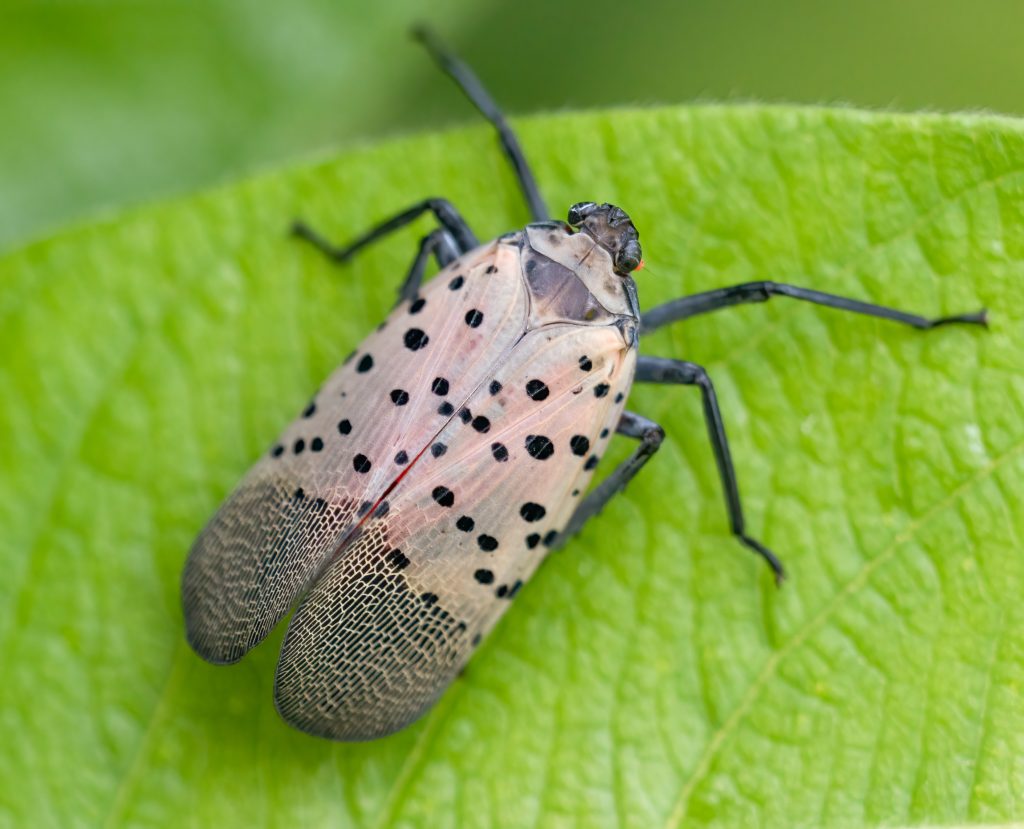by Beth Dolinar, Contributing Writer

Spotted Lanternfly
The first spotted lantern fly I ever laid eyes upon was in a netted cage at an apple orchard near Gettysburg, Pennsylvania. I was there in August 2022 with a photographer, filming a documentary about new jobs in agriculture.
That segment was about robots that researchers at Penn State University are developing to prune fruit trees. But while we were there, a researcher walked us over to the grape vines to show us the flies.
Dozens of them were crawling inside netted cages, a system researchers were using to keep track of their life cycles. The insects are a menace to vineyards and some other crops. The flies originated in China, and probably rode across the ocean on a cargo ship. Back in Asia, the flies aren’t as much of a menace because they have a natural predator, a parasitic wasp.
The lantern flies have no natural predator here. They have arrived at my doorstep, many dozens of them that have made it unpleasant if not plain awful for me to be outside during certain times of the day. The flies are everywhere, and scientists are telling us to stomp them, swat them, spray them or otherwise clobber them.
The first ones arrived on my patio in mid-August. I tried stomping, but they were just too fast, even when I approached from the front, as my more accomplished bug-squashing friends advised. The bugs would see my foot coming and jump out of the way. A fly swatter was just as ineffective.
The last weeks of August brought scorching hot afternoons. The flies gathered in groups around my downspouts and on my front door, perhaps because those surfaces were cooler than the bricks. Whatever, the heat was slowing the flies down (just as it slowed the rest of us down). If I stepped quickly enough—or swung the fly swatter fast enough—I could hit them before they jumped.
Each swat brought a sickening crunch and then a death spiral as the fly floated to the ground. Part of me—the part that would never kill a honey bee or swat at a grasshopper—felt a sense of inhumanity during my fly hunts; the flies are only fulfilling their evolutionary destiny, and besides, with their wings open they are actually quite pretty. Their red, black and white spots remind me of the whimsical MacKenzie-Childs pattern on my teapot.
But stomp them, we’ve been told, and so I stomp. Several times a day I go out there armed with a fly swatter and wearing a hat that covers all my hair. More than once, I’ve swatted flies from above my head, only to have an escapee land on me. I start at one end of the patio and make my way across the brick wall, crunching along, the flies falling like red and black flower petals to the ground. It’s satisfying—like popping some bubble wrap.
Experts say that for every one fly I kill this year, I prevent another 500 from hatching next year. (You’re welcome, August 2024!)
While out on my patio swatting bugs one Sunday afternoon, I heard a familiar slapping sound across the yard. It was my neighbor, swatting flies with a shoe. Like me, she was doing her part to protect the grape vines and the trees. As I flung my swatter at the bugs, over and over again, I wondered about those parasitic wasps that feed on lantern flies. Are plans in the works to bring them here, too?
Somehow, a parasitic wasp sounds like more of a menace than a fly. For now, the best we can do is keep swatting. And wear a hat.
***
 About the author: Beth Dolinar is a writer, Emmy-award winning producer, and public speaker. She writes a popular column for the Washington “Observer-Reporter.” She is a contributing producer of documentary length programming for WQED-TV on a wide range of topics. Beth has a son and a daughter. She is an avid yoga devotee, cyclist and reader. Beth says she types like lightning but reads slowly — because she likes a really good sentence.
About the author: Beth Dolinar is a writer, Emmy-award winning producer, and public speaker. She writes a popular column for the Washington “Observer-Reporter.” She is a contributing producer of documentary length programming for WQED-TV on a wide range of topics. Beth has a son and a daughter. She is an avid yoga devotee, cyclist and reader. Beth says she types like lightning but reads slowly — because she likes a really good sentence.

